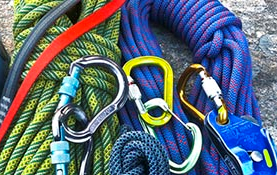Rope Differentiation: Static / Low Stretch / Dynamic Ropes - TERCOM Recommendation Nr. 7

Rope Differentiation:
Static / Low Stretch / Dynamic Ropes 20181020-TER-REC0007 / Terrestrial Rescue Commission
1. Introduction
This recommendation was written first in Sonthofen 1999. At this time canyoning rescue operations were an increasingly frequent rescue activity.
Before this, low stretch ropes/static ropes were typically only white or black and it was easy to differentiate between dynamic ropes and low stretch/static ropes.
Rope manufacturers began producing low stretch ropes for canyoning in a range of different colours and markings and the danger of confusion between dynamic ropes and low stretch ropes/static ropes has increased.
2. Recommendation
ICAR Commission for Terrestrial Rescue strongly recommends that rescue teams who have dynamic and low stretch or static ropes available for use in their rescue operations:
-
should implement a reliable and simple system to clearly differentiate between dynamic ropes and low stretch or static ropes
and
-
such a system should be well known and easily recognised by all team members when working in technical rescues.
3. Explanatory notes
Using a low stretch/static rope instead of a dynamic rope can increase risks in technical rescue when it is necessary to absorb energy in a dynamic way e.g. lead climbing.
The use of dynamic ropes in rope based rescues may introduce excessive stretch issues which can negatively affect control and increase impact risks when working with longer lengths.
If the use of low stretch ropes certified to the UIAA Safety Label Standard 107 is possible, then this is a possible solution for differentiation and helps to reduce errors in rope selection and inappropriate use.
4. Glossary
Please look at the attached PDF-Version
5. References
Please look at the attached PDF-Version